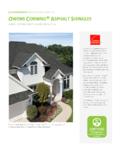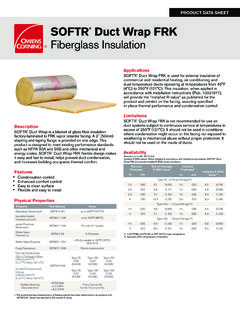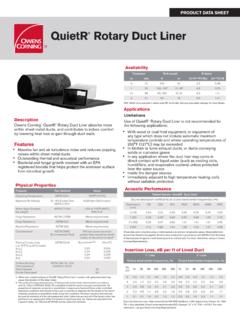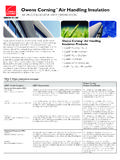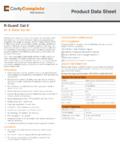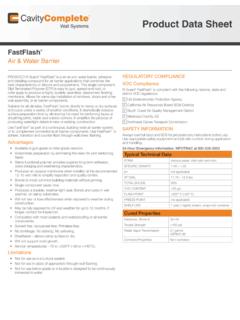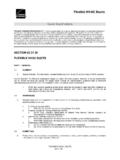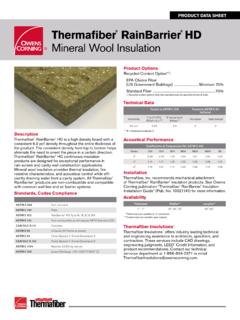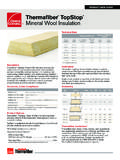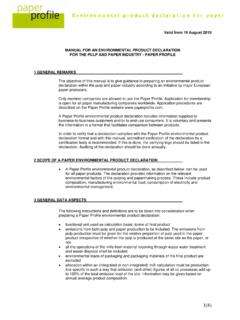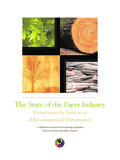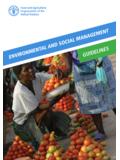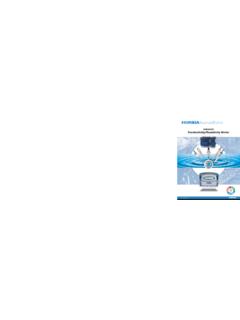Transcription of Environmental Product Declaration EcoTouch ... - …
1 The color PINK is a registered trademark of Owens Corning. 2012 Owens Corning. All Rights Unfaced InsulationEnvironmental Product DeclarationOwens Corning, and its family of companies, are a leading global producer of residential and commercial building materials, glass-fiber reinforcements, and engineered materials for composite systems. Founded in 1938, Owens Corning has earned its reputation as a market-leading innovator of glass-fiber technology by consistently providing new solutions that deliver a strong combination of quality and value to its customers across the world. Building Materials products primarily roofing and insulation are focused on making new and existing homes and buildings energy efficient, comfortable, and attractive. Owens Corning is committed to balancing economic growth with social progress and sustainable solutions to its building materials and composites customers around the world. This Environmental Product Declaration is a component of our stated goal to provide life cycle information on all core products.
2 Corning EcoTouch Insulation with PureFiber Technology enhances comfort, energy savings and sustainability in new and existing structures. EcoTouch Unfaced Insulation According to ISO 14025 This Declaration is an Environmental Product Declaration in accordance with ISO 14025 that describes the Environmental characteristics of the aforementioned Product . It promotes the development of sustainable products. This is a certified Declaration and all relevant Environmental information is disclosed. PROGRAM OPERATOR UL Environment Declaration HOLDER Owens Corning Declaration NUMBER DECLARED Product EcoTouch Unfaced Insulation. Manufactured by Owens Corning in the United States and Canada. REFERENCE PCR PCR Building Envelope Thermal Insulation (ULE 2011) DATE OF ISSUE October 29, 2012 PERIOD OF VALIDITY 5 years CONTENTS OF THE Declaration Product definition and information about building physics Information about basic material and the material s origin Description of the Product s manufacture Indication of Product processing Information about the in-use conditions Life cycle assessment results Testing results and verifications The PCR review was conducted by: UL Environment PCR was approved by Panel 333 Pfingsten Road Northbrook, IL 60062 This Declaration was independently verified in accordance with ISO 14025 by Underwriters Laboratories INTERNAL X EXTERNAL Loretta Tam This life cycle assessment was independently verified in accordance with ISO 14044 and the reference PCR by: Thomas P.
3 Gloria EcoTouch Unfaced Insulation According to ISO 14025 Product Definition and Information Product Description EcoTouch PINK FIBERGLAS Insulation with PureFiber Technology is flexible insulation and is made in R-values from 11 to 38 for United States markets. For the Canadian market, the R-Values are from 12 to 40. The unfaced insulation is manufactured in thicknesses from 31/2 to 12 . The functional unit of the Product as defined by the PCR is 1 square meter of insulation material with a thickness that gives an average thermal resistance RSIsi=1 m2K/W and with a building service life of 60 years. The results of this Declaration represent an average performance for a number of products and manufacturing plant locations. Manufacturing Locations Owens Corning North American Insulation Manufacturing Locations can be found across the United States and Canada. Delmar Planta Fuera Bush, 12067 Edmonton Plant Edmonton, Alberta, Canada T6S1A1 Fairburn Plant Fairburn GA.
4 , 30123 Kansas City Plant Kansas City, KS. 66115 Santa Clara Plant Santa Clara, CA. 95050 Toronto Plant Scarborough, Ontairo, Canada M1V1Z5 Waxahachie Plantb Waxahachie, TX 75165 (a) Manufacturing location was not included in LCA for unfaced insulation. (b) The Waxahachie plant was converted in May 2011 and uses the same process and bill of materials as the plants covered in the study. EcoTouch Unfaced Insulation According to ISO 14025 Application and Uses EcoTouch Insulation can be used in a wide range of exterior wall, floor, roofing and ceiling applications for residential and commercial installations. EcoTouch Insulation is provided with a wide range of R-values and thicknesses with excellent thermal control. The R30C, and R38C for use in the USA and R28 and R31 as used in Canada, provide excellent thermal performance in limited space of cathedral ceilings. EcoTouch Insulation enhances interior noise control by improving Sound Transmission Class (STC) of walls and floor/ceiling assemblies Installation EcoTouch Insulation is easy to handle and install.
5 Sized for installation in either wood or metal frame construction, Unfaced EcoTouch Insulation is friction fit into place. Trimming and fabrication can be done with a utility knife and can be cut to fit into odd-shaped cavities and small spaces. With less dust than other fiberglass insulation products, EcoTouch Insulation has excellent stiffness and recovery characteristics. EcoTouch Unfaced Insulation can be friction-fit between studs after the cover material has been installed on one side of the cavity. Use wire or metal straps to hold insulation in place in applications without a cover material, or where the insulation does not fit the depth of the cavity. Cathedral ceiling products are intended to be friction-fit between rafters. Cathedral ceiling insulation when installed per manufacturer s instructions is designed to provide a minimum of 1 ventilation passageway between the roof deck and insulation. For metal studs, EcoTouch Insulation can be friction-fit in place until the interior finish is applied.
6 Insulation should fill the cavity and the wall should eventually be closed on both sides EcoTouch Insulation can be applied between furring strips, hat channels, or Z-shaped furring in areas where a finished surface will be installed. Contact furring strip manufacturer for appropriate fastening system. EcoTouch Unfaced Insulation According to ISO 14025 Material Content Unfaced EcoTouch Insulation consists of two major components, the fiberglass and the binder system. The fiberglass is made from various inorganic minerals, which are referred to as batch chemicals. The binder system consists of renewable and non-renewable organic chemicals. Materials Function Quantity (% by Mass) Non-Renewable Renewable Recycle Material Origin Transportation Mode Transportation (Miles) Cullet Glass Batch 25-75% North America Rail/Truck 10-800 Sand Glass Batch 8-25% North America Truck 10-250 Borates Glass Batch 10-30% Global Ship/Rail/Truck 350-6200 Soda Ash Glass Batch North America Rail/Truck 350-2000 Other Oxides Glass Batch 1-2% North America Rail/Truck 225-2000 Limestone Glass Batch 0-5% North America Truck 125-200 Carbohydrate Polyol Binder 2-10% North America Truck 500-2200 Bio-Based Polycarboxlic Acid Binder 1-5% North America Truck 200-2000 Cure Accelerator Binder North America Truck 250-2300 Surfactant Binder North America Truck 400-2300 Vegetable Oil Binder North America Truck 500-2200 Silane Binder North America Truck 250-2700 Pink Colorant Binder North America Truck 350-2800 Table 1.
7 Material Content of Unfaced Fiberglass Insulation Manufacturing Process EcoTouch Unfaced Insulation According to ISO 14025 Environmental Product Declaration Use of Material and Energy Resources Table 1: Total Primary Energy Total Primary Energy Unit Total Non renewable, fossil MJ-Eq Non-renewable, nuclear MJ-Eq Renewable, biomass MJ-Eq Renewable, wind, solar, geothermal MJ-Eq Renewable, water MJ-Eq Table 2: Total Primary Energy Detail by Source Type Non-Renewable Primary Energy Source Unit Total Renewable Primary Energy Source Unit Total Fossil Oil MJ-Eq Hydropower MJ-Eq Natural Gas MJ-Eq Wind Power MJ-Eq Coal MJ-Eq Solar Power MJ-Eq Uranium MJ-Eq Biomass MJ-Eq Non-Renewable Energy by Source Renewable Energy by Source OilNatural PowerSolar PowerBiomass EcoTouch Unfaced Insulation According to ISO 14025 Use of Material and Energy Resources As shown by the pie chart, the fiberglass manufacturing process is energy intensive but since insulation is a passive device, the use phase consumes zero primary energy, and in fact actually saves energy in a building.
8 Life Cycle Assessment- Product System and Modeling of Life Cycle Functional Unit The functional unit of the Product as defined by the PCR is 1 square meter of insulation material with a thickness that gives an average thermal resistance RSI=1 m2K/W and with a building service life of 60 years. Life Cycle Stages Assessed The EcoTouch Insulation study for the manufacturing of unfaced fiberglass batts and rolls was a cradle-to grave analysis, which included the following: Raw material production including extraction of primary raw materials, raw material manufacturing, raw materials for packaging, recycle cullet collection and processing, All raw material, packaging material and recycle cullet material to manufacturing locations. Fiberglass manufacturing Packaging of Finished Goods. Finished Good Transportation to from Manufacturing Facilities to Distribution centers, and Retailers. End-of-Life; Decommissioned material transportation to Waste Landfill and Landfill.
9 MaterialsBinder MaterialsPackaging TransportFiberglass DistributionUseEnd of Life EcoTouch Unfaced Insulation According to ISO 14025 System Boundaries Assumptions Assumptions are critical in conducting a life cycle assessment. For this cradle-to-grave life cycle, a major assumption is for the installation, use and maintenance phase. Installing unfaced fiberglass batt is performed by hand. They are unrolled or unwrapped, cut to appropriate size and friction fit into a wall cavity between the studs. This activity requires no other external utility source such as electrically, or other fuel. Once the batt is installed, the interior wall is finished and the batt is completely encased and protected. During the sixty-year life of the home as defined in the study, the batt would require no other utility source to operate (passive device). Finally, unless some type of serious damage occurred to the wall of a home, the maintenance on a fiberglass batt would not be required.
10 In conclusion, for this study, a use/maintenance phase had zero impact value for the life cycle. The major benefit of insulation is that it saves energy over the life of the home. See section on Additional Environmental Benefits for energy savings for homes due to insulation of walls, ceilings, floors and foundations. All data reported is a North American weighted averaged for five of the six North American, Owens Corning plants that produced 71% unfaced residential batts/rolls for the year 2011. Cut-Off Criteria The cut-off criteria for the study are as follows: Mass If a flow is less than 2% of the cumulative mass of the model, it may be excluded, providing it Environmental relevance is not a concern. Energy If a flow is less than 1% of the cumulative energy of the model, it may be excluded, providing its Environmental relevance is not a concern, Environmental Relevance Materials of omission that may have a relevant contribution will be justified if applicable, by a sensitivity analysis.
